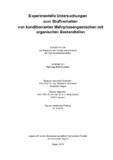Citation link:
http://dx.doi.org/10.25819/ubsi/2689Files in This Item:
| File | Description | Size | Format | |
|---|---|---|---|---|
| Dissertation_Martin_Loewen.pdf | 46.06 MB | Adobe PDF |  View/Open |
| Dokument Type: | Doctoral Thesis | metadata.dc.title: | Experimentelle Untersuchungen zum Stoffverhalten von konditionierten Mehrphasengemischen mit organischen Bestandteilen | Other Titles: | Experimental investigations of the continuum-mechanical behavior of treated multi-phase mixtures with organic matters | Authors: | Löwen, Martin | Institute: | Institut für Geotechnik Department Bauingenieurwesen Fakultät IV - Naturwissenschaftlich-Technische Fakultät |
Free keywords: | Peat, Building ground, Soil solidification | Dewey Decimal Classification: | 624 Ingenieurbau und Umwelttechnik | GHBS-Clases: | XCY WSWD |
Issue Date: | 2020 | Publish Date: | 2020 | Abstract: | Diese Arbeit behandelt das kontinuumsmechanische Verhalten von Mehrphasengemischen in Form von unbehandelten und konditionierten Böden mit organischen Bestandteilen/Beimengungen. In Böden enthaltene organische Bestandteile können das Verformungsverhalten von Böden maßgeblich beeinflussen. Böden mit organischen Bestandteilen, wie z. B. Torfe, zeigen zumeist ein vergleichsweise sehr ausgeprägtes Kompressionsverhalten. In Abhängigkeit von dem Zersetzungsgrad der organischen Bestandteile, dem Anteil der Organik und den damit verbundenen sehr hohen Wassergehalten ist eine Korrelation zur Tragfähigkeit feststellbar. Die im Rahmen der vorliegenden Dissertation durchgeführten Untersuchungen an Mehrphasengemischen (Boden/Boden-Bindemittel) erfolgten mit der Zielsetzung das Kompressionsverhalten sowie die Scherfestigkeit von Böden mit organischen Bestandteilen, in Abhängigkeit von der Zugabe verschiedener Bindemittel und -anteile, näher zu beschreiben und daraus einen verwendbaren Baustoff in Sinne eines Hochleistungs-Baustoffes-Bodens (HLBB) zu entwickeln. Die Untersuchungen an drei Torfen mit voneinander abweichenden bodenmechanischen Kennwerten – zur Erfassung einer großen Bandbreite und Aussagekraft – zeigen, dass eine Konditionierung/Stabilisierung – vorzugsweise mit Zementen – möglich ist, womit auch anstehende Torfhorizonte unter Verwendung von Spezialtiefbauverfahren (z.B. Mixed-in-Place- oder Mixed-in-Plant-Verfahren) als Baugrund nutzbar gemacht werden können. Voraussetzung dafür sind gezielte Laboruntersuchungen, um die bodenmechanischen Parameter der konditionierten Böden möglichst genau zu ermitteln. Dabei ist die Wahl der Initialspannung und der Zeitpunkt der Laststeigerung von grundlegender Bedeutung für das spätere Verformungsverhalten des mit Bindemitteln verbesserten Baugrundes. Mit dieser Arbeit soll – was bisher mit granularen Böden bei Mixed-in-Place und weiteren Verfahren bereits möglich ist – ein neuer, weiter reichender Ansatz im Sinne eines neuen „Designs“ des Baugrundes vorgestellt werden: Böden mit organischen Bestandteilen, anstelle einer Tiefgründung oder mit einem Austausch und Deponierung des originären Baugrundes, durch eine Konditionierung zu stabilisieren bzw. zu verfestigen, um eine Belastung des Stoffkreislaufs zu vermindern oder vollständig zu vermeiden. This dissertation deals with the continuum-mechanical behavior of multi-phase mixtures, untreated soils with organic matters and treated soils with organic matters. Organic matter content in soils can determine the deformation behavior of soils totally. Soils with organic components such as peat are well known for their high compressibility. Depending on the content and degradation of the organic matter, as well as the resulting water content a correlation to the bearing capacity of the soil can be established. The aim of the performed investigations on multi-phase mixtures (soil/soil with bonding agent) within the scope of this dissertation is to establish the compression and shear behavior of soils with organic content after adding different fractions of binding agent. The ultimate target is to develop a high-performance building material/soil that can be utilized. Hence, three peats with different soil-mechanical properties were investigated to cover a wide range of parameters and to gain trusted results. The results show that it is possible to stabilize the peats by conditioning with cement, thus a peat layer can be stabilized through special ground engineering methods (e.g. Mixed-in-Place- or Mixed-in-Plant-Methods) to become stable construction ground. However, the precondition for the success is to carry out laboratory investigations on the conditioned soils to obtain their precise soil-mechanical properties. In doing so, the selection of the initial stress and the timing for load increase are of eminent importance for the future deformation behavior of the improved soils.In this dissertation a new far-reaching approach in construction ground design for soils with organic content is introduced – till now it was possible to apply such concepts on granular soils using Mixed-in-Place and other methods – utilizing conditioning methods to stabilize soils with organic content instead of excavating and depositing the soil on landfills for replacement or instead of constructing deep foundations. This would minimize the pressure on the cycle of materials. |
DOI: | http://dx.doi.org/10.25819/ubsi/2689 | URN: | urn:nbn:de:hbz:467-16261 | URI: | https://dspace.ub.uni-siegen.de/handle/ubsi/1626 |
| Appears in Collections: | Hochschulschriften |
This item is protected by original copyright |
Page view(s)
557
checked on Apr 3, 2025
Download(s)
2,237
checked on Apr 3, 2025
Google ScholarTM
Check
Altmetric
Items in DSpace are protected by copyright, with all rights reserved, unless otherwise indicated.

